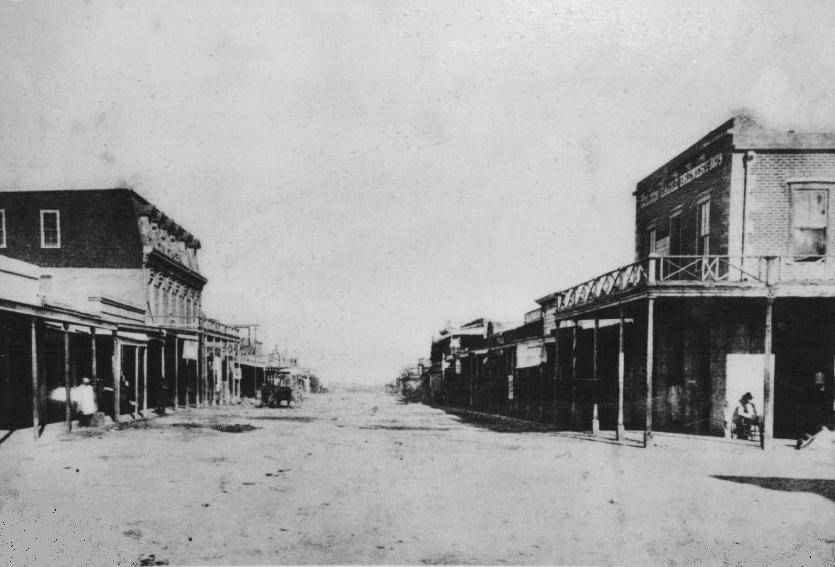
Allen Street circa 1882
Tombstone, Arizona is situated in the southeast region of Arizona which was acquired by the Gadsden Purchase on December 30, 1853. In July 1877, Ed Schieffelin, founder of Tombstone, made claim to Toughnut, Lucky Cuss and Contention mines where he found silver and ore. In January 1879, the Tombstone Mill and Mining Company was established and in April of 1879, the first house was built on the corner of Fourth Street and Allen Street by J. B. Allen where he managed and owned a store. In December 1879 Tombstone was incorporated as a village by the vote of the people, and under the order of the County Supervisors, became incorporated. William A. Harwood, Esq. became the first mayor of Tombstone. In January 1880 a new election was held and Allen Crandall was elected Mayor, with S. B. Comstock, Harry B. Jones, Caldwell, Smith and Gray as council members. Then, by March 20, 1880 the first railroad from Tombstone to Tucson was completed. During 1880, Tombstone began to attract much attention for mining and the town started to grow much more rapidly, when results from the Gird Mill began to be heard. By this time Tombstone had twelve large general merchandise stores, with quite assorted stocks. There were four hotels, nine restaurants, two drug stores, ten cigar stores, one candy factory, one photograph gallery, two watchmakers, two saddle and harness makers, two tinware and stove stores, two bakeries, one ice cream saloon, two furniture stores, several boot and shoe stores, four dry goods and millinery stores, one large store for furnishing goods, two banking houses: (The Pima County Bank and Safford, Hudson and Company) five assay offices and several saloons. In addition, The Grand Hotel opened in September 1880, along with the Russ House Hotel, known as the "Best Transient Hotel in Tombstone", where meals and rooms were only 50 cents each and Board was $8.00 per week. By 1881, Tombstone's population was estimated between 6,000-7,000 people. Then, in January 1881, the first telegraph was connected to all points of the Tombstone region. By January 31, 1881 Cochise County, where Tombstone resides, was created and by February 1881 Tombstone was officially incorporated as a city. Virgil Earp, the brother of former Marshal Wyatt Earp, became the Chief of Police on July 4, 1881 and on October 26, 1881 the Gunfight at the OK Corral took place, killing Tom McLowery, Frank McLowery and Billy Clanton.
In December 1881, brother Virgil Earp was shot in the back by an unknown assassin and the infamous Bird Cage Theater and brothel, was dedicated. In March of 1882, Morgan Earp was killed in an ambush and a few days later Wyatt Earp, Doc Holliday and their crew left Tombstone. By 1881, Tombstone became the County Seat of Cochise County. Presently the County Seat resides in Bisbee, Arizona another historic mining community located just 20 minutes south of Tombstone. Also in 1882, the Tombstone County Court House was built, containing the county jail and various other county offices, including a court room on the second floor. The total cost of the building at the time was $43,000 after completion. The City Hall is also built during this time costing $15,000. Schieffelin Hall, where the present day City Council meets, is located just across Fremont street on the opposite corner from the City Hall. Schieffelin Hall was known as the largest adobe building in the Southwest and was designed to serve as a theater, recital hall and meeting place for wealthy mine officials, doctors, lawyers, businessmen and their families.
Tombstone mining claims are located under the city
itself; the shafts, the hoist works and heaps of extracted ore of the Vizinia,
the Gilded Age, the Mountain Maid and several other mines open oddly enough
in the very midst of several of the buildings. This circumstance has
created several disputes over ownership due to conflicting titles to both
above ground and claims below ground. Located on a hill nearby are
the Tough Nut and Contention mines. A laborer above ground then earned
$3.50 and below ground earned $4.00 for a "shift" of eight hours and they
worked shifts night and day, seven days a week 365 days a year. By
1887 the Tombstone mines employed 400 people and the price of silver by 1890
was $1.05 per ounce. In January 1902, the first electric lights and
telephone system for Tombstone were in place. In 1910, the price of
silver had dropped to 50 cents per ounce and by 1930 the County Seat was
moved to Bisbee. Finally, on February 14, 1912, the territory
of Arizona reached its statehood and the city of Tombstone officially became
known as Tombstone, Arizona. Tombstone's survival of the Great Depression
and two devastating fires, along with the flooding of the mines seemed like
the death of Tombstone. However, the legends of Tombstone's past continue
to survive through the restoration of its many historic buildings and through
the daily tourism that make Tombstone known as "The Town Too Tough To Die".
|
Back To Home Page
|